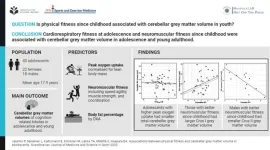(Press-News.org) Statement Highlights:
The new American Heart Association PREVENTTM risk calculator estimates the 10- and 30-year risk of total cardiovascular disease for people aged 30 years and older.
The calculator estimates the risk of heart attack, stroke and — for the first time — heart failure. The equations are sex-specific and race-free, acknowledging that race is not a biological factor, and can include an index of social determinants of health.
This is the first risk calculator that combines measures of cardiovascular, kidney and metabolic health to estimate risk for cardiovascular disease.
The calculator was developed using health information from more than 6 million adults, including people from diverse racial and ethnic, socioeconomic and geographic backgrounds.
Embargoed until 4 a.m. CT / 5 a.m. ET, Friday, Nov. 10, 2023
DALLAS, Nov. 10, 2023 — A new calculator estimates a person’s risk for cardiovascular disease (CVD) over the next 30 years by combining measures of cardiovascular, kidney and metabolic health for the first time, according to a new American Heart Association Scientific Statement published today in the Association’s flagship journal Circulation.
An accompanying methods paper, published simultaneously today in Circulation, shares details about the development and testing as well as the formulas for the new risk calculator. An online tool is in development.
The American Heart Association PREVENTTM (Predicting Risk of cardiovascular disease EVENTs) risk calculator estimates heart attack, stroke and heart failure risk. The calculator helps incorporate cardiovascular-kidney-metabolic or CKM syndrome into CVD prevention. CKM syndrome was first defined in an October 2023 presidential advisory and scientific statement. The syndrome refers to the strong connections among cardiovascular disease, kidney disease and metabolic disease (Type 2 diabetes and obesity).
According to the Association’s 2023 Statistical Update,1 in 3 U.S. adults has three or more risk factors that contribute to cardiovascular disease, kidney disease and/or metabolic disorders. As the underlying conditions of CKM syndrome worsen, the risk of heart attack, stroke, and/or heart failure increases.
“A new cardiovascular disease risk calculator was needed, particularly one that includes measures of CKM syndrome, which is highly prevalent in the U.S.,” said Sadiya S. Khan, M.D., M.Sc., FAHA, chair of the statement writing committee for the Association. “The new PREVENT risk calculator enables clinicians to quantify this risk and may help people receive preventive care or treatment earlier to reduce CVD risk.”
The PREVENT risk calculator uniquely quantifies risks for CVD for each biological sex. As more research has been conducted specifically in women, this is an important way to understand their unique differences in CVD presentation and risk factors. PREVENT does not include race in its calculation, acknowledging that race is a social factor and not a biological variable and, therefore, is not a valid factor for predicting CVD risk. There is an option in PREVENT to include social factors if available.
The last CVD risk calculator, the Pooled Cohort Equation, was released in 2013. “However, new treatments are now available for CKM conditions such as obesity, Type 2 diabetes and kidney disease,” said Khan, who is the Magerstadt Professor of Cardiovascular Epidemiology and an associate professor of medicine (cardiology) and preventive medicine (epidemiology) at Northwestern University’s Feinberg School of Medicine and a preventive cardiologist at Northwestern Medicine, both in Chicago.
“Estimating a person’s risk for CVD related to these conditions with the new PREVENT risk calculator should prompt conversations between health professionals and patients to increase awareness of CKM health status and CVD risk, and to translate that awareness into actions that improve health and reduce risk,” said Khan. “This includes health and lifestyle changes (routine physical activity, eating healthy foods) and possibly medications, if appropriate.”
A risk calculator uses health, demographic and/or socioeconomic information in equations to calculate a risk estimate or score. Equations are developed by scientists based on information in national databases, large research studies and electronic health records.
The PREVENT equations were developed using data from more than 6 million adults in the U.S. from a variety of racial and ethnic, socioeconomic and geographic backgrounds. Information from the health records of about half of those people was used to develop the calculator, then it was verified in the other half. Some data were collected from research studies, while other data were drawn from the electronic medical records of people seeking regular health care outside of a research setting. With this broad population, the calculator is more likely to accurately represent and be applicable to the general adult population in the U.S.
PREVENT equations use screening tests already in use in primary care to predict risk. Blood pressure measurement; blood tests for cholesterol, blood sugar and kidney function; and questions about tobacco use and whether people take medications for CVD risk factors are common in health assessments. This information can be entered in the PREVENT risk calculator, along with a person’s age and sex, to determine estimated risk.
Key differences in the PREVENT calculator compared to the Pooled Cohort Equations include:
PREVENT is for adults as young as age 30 and estimates 10-year and 30-year risk of total cardiovascular disease.
The Pooled Cohort Equations were designed to assess 10-year risk of heart attack and/or stroke for people ages 40-79. The new calculator can assess CVD risk in people from ages 30 to 79, and it can predict risk for heart attack, stroke and/or heart failure over the next 10 years and 30 years.
“Longer-term estimates are important because short-term or 10-year risk in most young adults is still going to be low. We wanted to think more broadly and apply a life-course perspective,” Khan said. “Providing information on 30-year risk may reveal earlier opportunities for intervention and prevention efforts in younger people.”
PREVENT can also inform a person’s CKM syndrome stage when risk is high to help guide further assessments and treatment recommendations. CKM syndrome ranges from Stage 0, or no risk factors and an entirely preventive focus, to Stage 4, the highest-risk stage, when cardiovascular disease is already present.
The PREVENT risk calculator includes measures of kidney function.
Kidney function is important in cardiovascular health, and chronic kidney disease increases cardiovascular risks. The calculator includes estimated glomerular filtration rate and allows for the use of urine albumin excretion (which monitors kidney disease) to further individualize risk assessment and help inform personalized treatment options.
The PREVENT risk calculator includes a measure of metabolic health.
The PREVENT equations allow the inclusion of hemoglobin A1C, a measure of blood sugar control, if necessary to monitor metabolic health. Abnormal blood sugar is associated with CVD risk in people with and without Type 2 diabetes.
Heart failure risk prediction is included.
Heart failure is a serious condition in which the heart isn’t pumping well enough to keep up with the body’s need for oxygen-rich blood. Heart failure is especially important in the context of CKM syndrome. Among people with obesity, Type 2 diabetes and/or kidney disease, the risk for heart failure can be higher than the risk for heart attack or stroke.
Risk calculations are race-free.
While there are clear racial and ethnic disparities in CVD risk factors and in the incidence of CVD among people based on the social construct of race and ethnicity, the statement writing committee concluded that race should not be included in the PREVENT calculator.
This decision is in line with a growing consensus in the scientific and medical community to remove race from algorithms in medical care to reduce the potential for race-specific treatment decisions.
“The Pooled Cohort Equations were developed with data from only White and Black adults and had separate equations for people of each race. There was not a risk model for individuals from other race and ethnicity groups, so we likely were not accurately estimating risk in many people,” Khan said. “Part of the rationale for race-specific equations was that race was considered a proxy or substitute for the lived experience of racism and its potential health effects. However, we were concerned that the inclusion of race as a proxy may still be harmful.”
The PREVENT calculator has similar accuracy among varied racial and ethnic groups. Also, the equations include the option to use the Social Deprivation Index, which incorporates measures of adverse social determinants of health such as education, poverty, unemployment and factors based on a person’s environment.
“The PREVENT equations are a critical first step toward including CKM health and social factors in risk prediction for CVD,” Khan said. “Concerted research efforts are needed to determine the causal and social factors that underlie racial differences in CVD risks and outcomes. As we strive towards more equitable preventive care, we also acknowledge that racism, and not race, operates at multiple levels to increase risk for CVD.”
Knowledge gaps and areas for more research.
The statement includes an assessment of gaps in knowledge and suggestions on where the PREVENT equations could be further refined with more research. These include:
Incorporating “net benefit” to identify the expected benefit of treatment recommendations based on an individual’s level of risk.
Collecting more data from people of diverse race and ethnic backgrounds to better represent the increasing diversity in the U.S. The number of Hispanic and Asian people included in the PREVENT datasets is lower than national estimates in the general U.S. population, so risk estimations in these populations may be less precise.
Expanding the collection, reporting and standardization of social determinants of health data, such as individual information rather than neighborhood information. Future research should prioritize systematic assessment of social factors so health impacts of structural racism may be better understood and addressed.
Expanding risk assessment and prevention to earlier in life (childhood and/or adolescence) and in key life periods, such as during the peripartum period since adverse pregnancy outcomes are associated with increased CVD risk.
Investigating whether predicting adverse kidney outcomes, particularly among people with and without Type 2 diabetes, may further optimize cardiovascular risk prediction.
This scientific statement was prepared by the volunteer writing group on behalf of the American Heart Association. The Association’s scientific statements promote greater awareness about cardiovascular diseases and stroke issues and help facilitate informed health care decisions. Scientific statements outline what is currently known about a topic and what areas need additional research. While scientific statements inform the development of guidelines, they do not make treatment recommendations. American Heart Association guidelines provide its official clinical practice recommendations.
The list of co-authors/members of the writing group and their disclosures are in the manuscript.
The Association receives funding primarily from individuals. Foundations and corporations (including pharmaceutical, device manufacturers and other companies) also make donations and fund specific Association programs and events. The Association has strict policies to prevent these relationships from influencing science content. Revenues from pharmaceutical and biotech companies, device manufacturers and health insurance providers, and the Association’s overall financial information are available here.
Additional Resources:
Available multimedia is on the right column of the news release link.https://newsroom.heart.org/news/leading-cardiologists-reveal-new-heart-disease-risk-calculator?preview=b96ba17802bb9e2df9a26dbe63c859e9
After Nov. 10, view the manuscript and methods paper online.
The scientific statement will be discussed at the American Heart Association’s Scientific Sessions conference at 9:45 am ET, Sunday, Nov. 12, 2023, during a session titled “A Confluence of Risk: Navigating the Intersection of Cardiovascular, Kidney and Metabolic Health.”
AHA Presidential Advisory: Heart disease risk, prevention and management redefined
AHA news releases:
Simple blood test may predict future heart, kidney risk for people with Type 2 diabetes (Aug 2023)
Redlining linked to higher heart failure risk among Black adults in U.S. (July 2023)
Analysis finds multiple social disadvantages magnify stroke risk (July 2020)
Follow AHA/ASA news on X @HeartNews
About the American Heart Association
The American Heart Association is a relentless force for a world of longer, healthier lives. We are dedicated to ensuring equitable health in all communities. Through collaboration with numerous organizations, and powered by millions of volunteers, we fund innovative research, advocate for the public’s health and share lifesaving resources. The Dallas-based organization has been a leading source of health information for nearly a century. Connect with us on heart.org, Facebook, X or by calling 1-800-AHA-USA1.
###
END
Leading cardiologists reveal new heart disease risk calculator
Cardiovascular, kidney and metabolic health measures included in new PREVENT risk calculator, detailed in a new American Heart Association Scientific Statement
2023-11-10
ELSE PRESS RELEASES FROM THIS DATE:
Physical fitness since childhood predicts cerebellar volume in adolescence
2023-11-10
Physical fitness since childhood is associated with cerebellar grey matter volume in adolescents. According to a recent study conducted at the University of Jyväskylä and the University of Eastern Finland, those who were stronger, faster and more agile, in other words, had better neuromuscular fitness since childhood, had larger Crus I grey matter volume in adolescence.
Despite the importance of the developing cerebellum on cognition and learning, the associations between physical fitness and cerebellar volume in adolescents have remained unclear. This study examined the associations ...
Scientists found hundreds of toxic chemicals in recycled plastics
2023-11-10
When scientists examined pellets from recycled plastic collected in 13 countries they found hundreds of toxic chemicals, including pesticides and pharmaceuticals.
The results are published in a study led by scientists at the University of Gothenburg.
Because of this, the scientists judge recycled plastics unfit for most purposes and a hinder in the attempts to create a circular economy.
Delegates, scientists and health and environmental advocates from around the world are traveling to Nairobi, Kenya for next week’s meeting of the third session of the Plastics Treaty Intergovernmental Negotiating ...
New cooling ceramic can enhance energy efficiency for the construction sector and help combat global warming—City University of Hong Kong research
2023-11-10
A significant breakthrough in developing a passive radiative cooling (PRC) material has been announced by researchers at City University of Hong Kong (CityU). The findings have just been published in the prestigious scientific journal Science titled “Hierarchically structured passive radiative cooling ceramic with high solar reflectivity.”
The material, known as cooling ceramic, has achieved high-performance optical properties for energy-free and refrigerant-free cooling generation. Its cost-effectiveness, durability and versatility make it highly suitable for commercialisation in numerous applications, particularly in ...
CNIC scientists identify the crucial role of the protein neuregulin-1 in heart development
2023-11-10
In a study published in the journal Circulation Research, researchers at the Centro Nacional de Investigaciones Cardiovasculares (CNIC) led by Dr. José Luis de la Pompa reveal the essential role of the protein neuregulin-1 (Nrg1) in the intricate transformation of the heart from its delicate primordial structure into a powerful pumping organ.
The findings not only highlight the pathways through which the human heart forms, but also suggest important directions for future medical advances. Commenting on the study, Dr. de la Pompa, head of the ...
Bullying victims who perceive they’re targeted due to social characteristics feel the effects worse, new research suggests
2023-11-10
Students who feel they have been victimized because of social characteristics such as their ethnicity or their sexuality are at additional risk of trauma, a new national US study has revealed.
Published in the peer-reviewed Journal of School Violence, the research, of more than 2,200 young victims of bullying, found students reported that their physical health; self-esteem; social relationships, and schoolwork suffered more if they felt bias was behind the perpetrators’ actions.
This was particularly ...
Any activity is better for your heart than sitting – even sleeping
2023-11-10
The study, supported by the British Heart Foundation (BHF) and published in the European Heart Journal, is the first to assess how different movement patterns throughout the 24-hour day are linked to heart health. It is the first evidence to emerge from the international Prospective Physical Activity, Sitting and Sleep (ProPASS) consortium.
Cardiovascular disease, which refers to all diseases of the heart and circulation, is the number one cause of mortality globally. In 2021, it was responsible for one in three ...
Health: Lack of friend or family visits is associated with increased risk of dying
2023-11-10
Never being visited by friends or family is associated with an increased risk of dying, according to a study published in BMC Medicine. The authors suggest that their findings could be used to help identify patients at a higher risk of dying due to social factors, and to develop more effective interventions to combat the increased risk of death associated with social isolation.
Although previous research has identified associations between deaths due to any causes and both a ‘sense of loneliness’ and living alone, the combined impacts of different types of social interaction ...
Aid agencies are failing patients with breast cancer in war zones meaning more will develop advanced disease
2023-11-10
Lisbon, Portugal: Patients with breast cancer in conflict zones around the world are being “massively under-served” by governments, UN aid agencies and other non-governmental organisations (NGOs), Professor Richard Sullivan told the Advanced Breast Cancer Seventh International Consensus Conference (ABC 7). [1]
Among people fleeing conflict zones, either displaced within their own country or across borders to other countries, patients with breast cancer are the “single largest group of cancer patients that present to UN agencies and international NGOs,” said Prof. Sullivan, who is director of the Institute of Cancer Policy and co-director of the Centre for ...
Is the US reporting system for vaccine safety broken?
2023-11-10
Is the US reporting system for vaccine safety broken?
Investigation raises concerns that the system is not operating as intended and signals are being missed
A US reporting system designed to detect potential safety issues with vaccines is supposed to be user-friendly, responsive, and transparent. But an investigation published by The BMJ today finds it’s not meeting its own standards.
The Vaccine Adverse Event Reporting System (VAERS), co-managed by the US Centers for Disease Control and Prevention (CDC) and the Food and Drug Administration (FDA), collects reports of symptoms, ...
Gut bacteria protects against diarrhoeal disease
2023-11-10
Gut bacteria protects against diarrhoeal disease
Peer reviewed - Systematic review – people and animals
The severity of a diarrhoeal disease could be down to the bacteria in your gut – according to new research from the University of East Anglia.
Cryptosporidiosis is responsible for over 100,000 deaths annually – predominantly in children under five.
It also affects animals, and a new study published today shows that large animals – including primates - with less different ...
LAST 30 PRESS RELEASES:
Numbers in our sights affect how we perceive space
SIMJ announces global collaborative book project in commemoration of its 75th anniversary
Air pollution exposure and birth weight
Obstructive sleep apnea risk and mental health conditions among older adults
How talking slows eye movements behind the wheel
The Ceramic Society of Japan’s Oxoate Ceramics Research Association launches new international book project
Heart-brain connection: international study reveals the role of the vagus nerve in keeping the heart young
Researchers identify Rb1 as a predictive biomarker for a new therapeutic strategy in some breast cancers
Survey reveals ethical gaps slowing AI adoption in pediatric surgery
Stimulant ADHD medications work differently than thought
AI overestimates how smart people are, according to HSE economists
HSE researchers create genome-wide map of quadruplexes
Scientists boost cell "powerhouses" to burn more calories
Automatic label checking: The missing step in making reliable medical AI
Low daily alcohol intake linked to 50% heightened mouth cancer risk in India
American Meteorological Society announces Rick Spinrad as 2026 President-Elect
Biomass-based carbon capture spotlighted in newly released global climate webinar recording
Illuminating invisible nano pollutants: advanced bioimaging tracks the full journey of emerging nanoscale contaminants in living systems
How does age affect recovery from spinal cord injury?
Novel AI tool offers prognosis for patients with head and neck cancer
Fathers’ microplastic exposure tied to their children’s metabolic problems
Research validates laboratory model for studying high-grade serous ovarian cancer
SIR 2026 delivers transformative breakthroughs in minimally invasive medicine to improve patient care
Stem Cell Reports most downloaded papers of 2025 highlight the breadth and impact of stem cell research
Oxford-led study estimates NHS spends around 3% of its primary and secondary care budget on the health impacts of heat and cold in England
A researcher’s long quest leads to a smart composite breakthrough
Urban wild bees act as “microbial sensors” of city health.
New study finds where you live affects recovery after a hip fracture
Forecasting the impact of fully automated vehicle adoption on US road traffic injuries
Alcohol-related hospitalizations from 2016 to 2022
[Press-News.org] Leading cardiologists reveal new heart disease risk calculatorCardiovascular, kidney and metabolic health measures included in new PREVENT risk calculator, detailed in a new American Heart Association Scientific Statement



